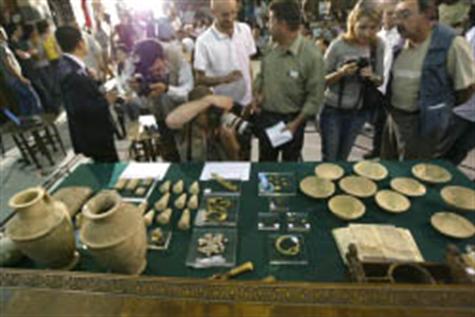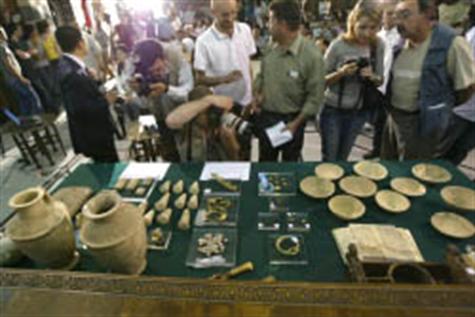Experts assess extent of Iraq’s cultural catastrophe five years after the US invasion

BAGHDAD / IraqiNews.com: When US forces stormed Baghdad on April 8, 2003 and, in a carefully staged propaganda stunt, tore down a statue of Saddam Hussein in Firdos Square, the first center of the former regime the GIs occupied was the Oil Ministry. That pretty much demonstrated what the Americans’ priorities were when they invaded the previous month.
As the grunts cordoned off the ministry, across town gangs were already rampaging through the 18 galleries of the Iraqi National Museum in a looting frenzy. They broke into storage vaults and steel cases to pillage priceless treasures from mankind’s first civil societies, the birthplace of the written word, codified laws, organized religion, science, war and agriculture.
Iraq‘s National Museum was founded in 1926 by Gertrude Bell, the intrepid British explorer and administrator.
It was arguably the most important repository of antiquities, chronicling more than 8,500 years of human history. The region is known as the cradle of civilization, where in 3,500 BC the first cities arose in a cluster across lower Mesopotamia – “the land between the two rivers,” the Euphrates and the Tigris.
As US forces toppled Saddam in 2003, then-US Defense Secretary Donald Rumsfeld voiced the Bush administration’s attitude toward the plundering. “Stuff happens,” Rumsfeld grumbled when questioned about the looting. “Freedom’s untidy and free people are free to make mistakes and commit crimes and do bad things.” Not much has changed.
Donny George Youkhanna, Iraq‘s most prominent archaeologist and National Museum director in 2003, called the looting “the crime of the century.” He said that some 14,000 objects, a dozen of them “world-class masterpieces,” were plundered from the museum. Fewer than half have been located and some of the most prized treasures have vanished into the hidden world of the private art collector, possibly never to be seen again.
George, who was also president of the state board of antiquities and heritage, was forced to flee with his family to Syria on August 27, 2006, thence to the US, because of alleged threats from the Shiite Islamists who by then ran Iraq. He is now visiting professor of anthropology at Stony Brook State University in New York.
The looting of the museum went on for five days, April 8-12, before US troops were deployed around the building. The looters – some clearly organized to go after specific treasures, presumably for sale to rapacious collectors prepared to pay top dollar – then fanned out across a country plunged into chaos by the invasion and the collapse of the Baath regime. Museums in other cities, such as Mosul in the north and Babylon in the south, were looted or torched and irreplaceable Islamic books, maps and manuscripts disappeared or went up in smoke.
Five years later, robber gangs still loot Iraq‘s cultural heritage at the estimated 11,000 archaeological sites across the country, with dealers buying the protection of the clans who control large tracts of the country. A 1,400-strong Mobile Archaeological Site Protection Force was mustered in 2006 but it proved to totally ineffective – usually outgunned by the gangs, its men poorly paid and motivated. Security officials estimate that it would take a force of 50,000-75,000 to protect the sites properly – and there’s little prospect of that amid the chaos of Iraq.
The robber groups are highly organized, sometimes heavily armed, often numbering 200-300 men, and, archaeological experts say, often financed by unscrupulous foreign dealers. They are ripping apart these sites, some of which had not even been officially excavated. Some of these illicit digs are family affairs, with impoverished Iraqis seeking to make a few dollars from pottery shards and other relics.
Most are massive quarrying operations with bulldozers, mechanical diggers and dump trucks. They are operating in broad daylight with virtual impunity since protecting these sites is low on US security priorities. Many of the plundered sites are now barren, cratered moonscapes because of the holes dug by the looters.
This rape of Mesopotamia’s fabled history, archaeologists say, is probably more devastating than the pillaging of the museums because priceless artifacts that cast light on mankind’s origins are being lost, so that experts cannot piece together how ancient societies developed.
“We may never know how many Gilgamesh-like epics have been lost,” lamented Mehiyar Kathem, a fundraiser for the Cultural Heritage Awareness Initiative, a project of the Baghdad-based educational non-governmental organization Culture For All. He calls the wholesale looting “one of the greatest catastrophes to befall humanity.”
McGuire Gibson, a professor of Mesopotamian history at the University of Chicago who has led major archaeological projects in Iraq, estimated in early 2007 that up to 15,000 objects were being taken daily from these sites.
Few of the plundered sculptures, gold and silver jewelry and 5,000-year-old cuneiform tablets – clay blocks containing the world’s earliest known writing – are likely to show up on the open antiquities market because they are well known and lists of the stolen items have been circulated to recognized dealers and auction houses.
The stolen items will be sold on the black market for millions of dollars. Gibson noted that, before last month – when Damascus handed over 700 looted pieces confiscated while being transported across into Syria – “maybe two” of the 4,000 items stolen from Iraqi museums since the 1991 Gulf War have been recovered.
Matthew Bogdanos, a New York assistant district attorney and a colonel in the US Marine Corps reserve who served in Iraq in 2003, said on March 18 that the smuggling of stolen antiquities was helping finance insurgent groups in Iraq.
Bogdanos has been praised by archaeological experts for being one of the few US officers who made any attempt to protect the National Museum in Baghdad and recover stolen antiquities. During a two-day United Nations conference in Athens on returning antiquities to their countries of origin, Bogdanos said there were “undeniable” links between the smuggling and extremist groups.
“The Taliban uses opium to finance their activities in Afghanistan,” he said. “Well, they don’t have opium in Iraq. What they have an almost limitless supply of is antiquities.”
Archaeologists and historians believe that employees, who knew where the most precious objects were located, perpetrated the most sophisticated looting of the National Museum. Bogdanos has no doubts.
“It’s well known, well proven that much of the theft from the museum were from museum insiders and senior government officials,” he said. “That’s clear. Not all of it by any means, but much of it.”
Security officials are skeptical about the extent that profits from the illicit sale of antiquities fund the insurgency. Donny George talks of “a huge mafia for smuggling antiquities” and says “there are a lot of people inside Iraq” near the plundered sites “buying these things from the looters there. They’re not Iraqis. They’re Europeans.” Other corrupt dealers, he says, have operated from Iran, Turkey, Kuwait and Saudi Arabia.
George said that the looters who plundered the National Museum “knew what they wanted. These were not random looters. They had glass cutters and even sets of keys which they left behind. The replica items, which would have looked real to a mob, were untouched.”
According to Lebanese archaeologist Joanne Farchakh-Bajjaly – a tireless campaigner for international action to help staunch this archaeological catastrophe, who helped document the stolen treasures – says the looters have ransacked sites of 4,000-year-old Sumerian cities in the south.
“In the Nassariyya area alone, there are about 840 Sumerian sites. They have all been systematically looted,” she said. The robber gangs have not spared “one meter of these Sumerian capitals that have been buried under the sand for thousands of years.
“They systematically destroyed the remains of this civilization in their tireless search for sellable artifacts … Humankind is losing its past for a cuneiform tablet or a sculpture or piece of jewelry that the dealer buys and pays for in cash in a country devastated by war.”
Farchakh warns that the looting is eradicating the ancient history of Mesopotamia. These days, she says, “the robbers are destroying everything because they’re going down to bedrock. What’s new is that the looters are becoming more and more organized, apparently with lots of money.
“Quite apart from this, military operations are damaging these sites forever. There’s been a US base at Ur for five years and the walls are cracking because of the weight of military vehicles. It’s like putting an archaeological site under a continuous earthquake.”

